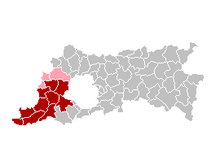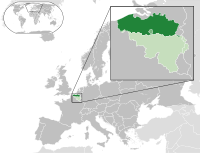
Dilbeek is a municipality in the province of Flemish Brabant, in the Flemish region of Belgium. The municipality comprises the villages of Dilbeek proper, Groot-Bijgaarden, Itterbeek, Schepdaal, Sint-Martens-Bodegem, and Sint-Ulriks-Kapelle. Dilbeek is located just outside the Brussels-Capital Region, in the Pajottenland, hence the local name Poort van het Pajottenland. Even though Dilbeek is located in the Dutch language area of Belgium, there is a French-speaking minority represented by 3 members on the 35-seat local council. It is a mostly residential community with some preserved rural areas and some industrial zones.
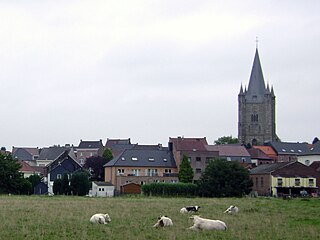
Herne is a municipality in the province of Flemish Brabant, in Flanders, one of the three regions of Belgium. It is also situated in the region of the Pajottenland. The municipality comprises the towns of Herfelingen, Herne proper and Sint-Pieters-Kapelle. On January 1, 2006, Herne had a total population of 6,407. The total area is 44.63 km² which gives a population density of 144 inhabitants per km².
Articles related to Belgium include:

Halle is a city and municipality of Belgium, in the district (arrondissement) Halle-Vilvoorde of the province Flemish Brabant. It is located on the Brussels-Charleroi Canal and on the Flemish side of the language border that separates Flanders and Wallonia. Halle lies on the border between the Flemish plains to the North and the undulating Brabant lands to the South. The city also borders on the Pajottenland to the west. The official language of Halle is Dutch. It is about 22 km southwest of Brussels.

Lambic is a type of beer brewed in the Pajottenland region of Belgium southwest of Brussels and in Brussels itself since the 13th century. Types of lambic beers include gueuze, kriek lambic, and framboise. Lambic differs from most other beers in that it is fermented through exposure to wild yeasts and bacteria native to the Zenne valley, as opposed to exposure to carefully cultivated strains of brewer's yeast. This process gives the beer its distinctive flavour: dry, vinous, and cidery, often with a tart aftertaste.

The area within Belgium known as Brussels-Halle-Vilvoorde encompasses the bilingual—French and Dutch—Brussels-Capital Region, which coincides with the arrondissement of Brussels-Capital and the surrounding Dutch-speaking area of Halle-Vilvoorde, which in turn coincides with the arrondissement of Halle-Vilvoorde. Halle-Vilvoorde contains several municipalities with language facilities, i.e. municipalities where French-speaking people form a considerable part of the population and therefore have special language rights. This area forms the judicial arrondissement of Brussels, which is the location of a tribunal of first instance, enterprise tribunal and a labour tribunal. It was reformed in July 2012, as part of the sixth Belgian state reform.
The High Council for Artisanal Lambic Beers is a non-profit organisation that brings together the gueuze brewers and blenders of the Pajottenland and Zenne Valley in Belgium.

Ruisbroek is a village in the municipality of Sint-Pieters-Leeuw, in the Belgian province of Flemish Brabant. Previously a separate municipality, it became a deelgemeente of Sint-Pieters-Leeuw in 1977. Due to its proximity to the Brussels Capital Region, the Brussels-Charleroi Canal, the Zenne river, the railway Brussels—Mons—Quévy and the Brussels outer ring (R0), the ward is heavily urbanised.

The Brussels Ring numbered R0, is a ring road surrounding the city of Brussels as well as other smaller towns south of Brussels. It is about 75 kilometres (47 mi) long, with 2 or 3 lanes in each direction. While most of it is classified as a motorway (highway), part of it is merely an express route. It crosses the 3 regions of Belgium: its main part is situated in Flanders, whereas Wallonia comprises 18.2 kilometres (11.3 mi) of the total stretch and 5.5 kilometres (3.4 mi) is on Brussels territory.

The Belgian railway line 50 is a railway line in Belgium connecting Brussels to Ghent. The first section between Ghent and Schellebelle was finished in 1837, offering a connection to Brussels through Dendermonde and Mechelen. The section between Schellebelle and Brussels was completed on 1 May 1856.
Sint-Ulriks-Kapelle is a village and deelgemeente of Dilbeek.
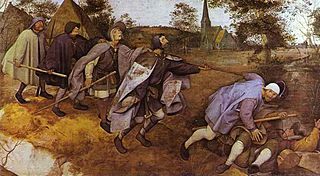
Itterbeek is a historical village in the province of Flemish Brabant, Belgium, and since 1977 a submunicipality of Dilbeek.
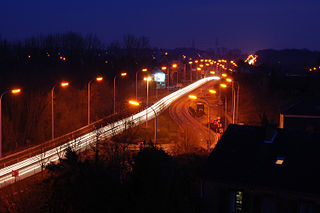
Schepdaal is a village and deelgemeente of Dilbeek in Flanders, Belgium.
Vlezenbeek is a small town of 3,324 in the Flemish Brabant southwest of Brussels, Belgium. It is part of the municipality Sint-Pieters-Leeuw. It is the home of Neuhaus, an international exporter of fine Belgian chocolate, as well as Lindemans Brewery, a brewery that produces lambics, a distinctly Belgian type of beer.

The Brussels Periphery refers to 19 Flemish municipalities that encircle the Brussels-Capital Region. The Brussels Region is an enclave of the province of Flemish Brabant.

St. Anna's Church is a Roman Catholic church in Sint-Anna-Pede, in the municipality of Dilbeek, Belgium, built around 1250. It is depicted in the painting The Blind Leading the Blind by Pieter Breughel the Elder.

Guillaume Wittouck was a Belgian lawyer and High Magistrate. He was the Grandfather of industrialist Paul Wittouck and of Belgian navigator Guillaume Delcourt.
The family Orinx are an age-old family of millers in Pajottenland and neighbouring regions Hainaut, East Flanders and Walloon Brabant in Belgium. A family member played a prominent part in the creation of the Belgian Draught horse at the end of the 19th century.
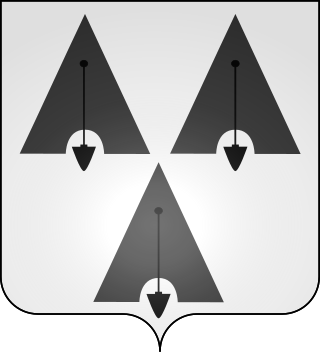
The Wittouck family (/witʊk/) is a noble Belgian family, that descends from the Seven Noble Houses of Brussels, established in Brussels since the 18th century.
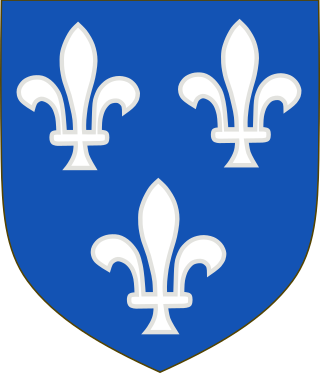
The Pipenpoy family (/pɪpɒ̃pwə/), was an old and influential patrician family of Brussels which exercised public functions in the capital of the Duchy of Brabant until the end of the Ancien Régime. It died in 1832 with Catherine de Pipenpoy, who was 100 years old. Several of its members were admitted to the Seven Noble Houses of Brussels.
